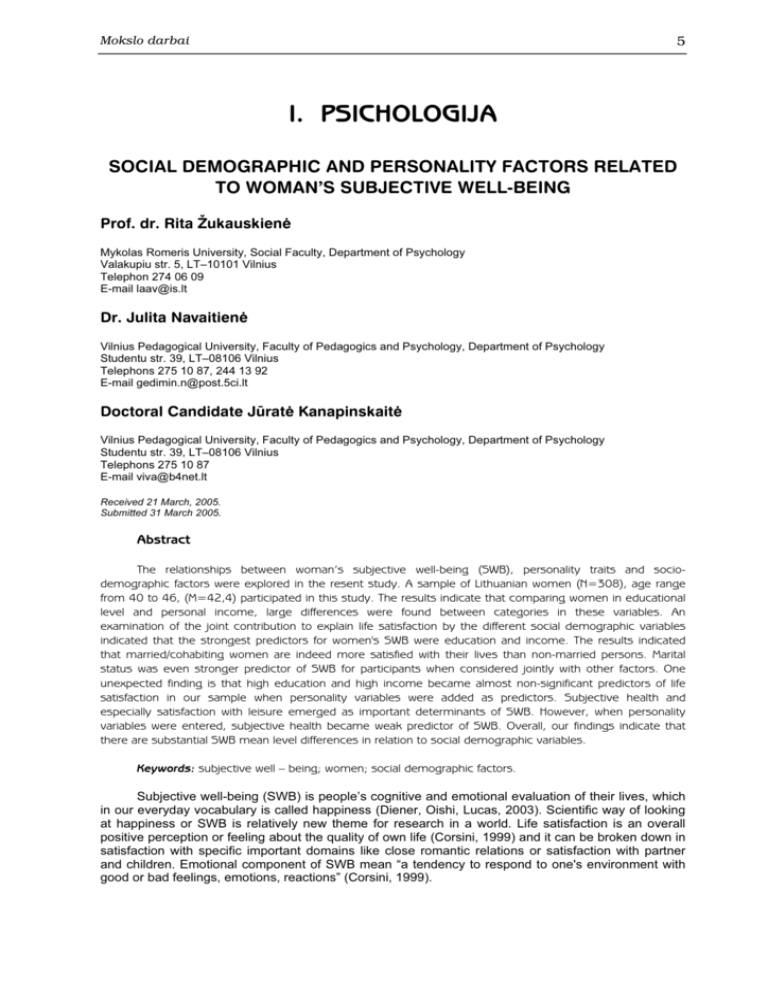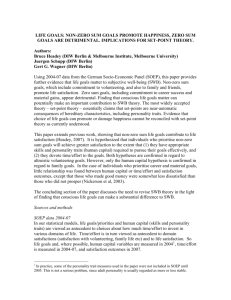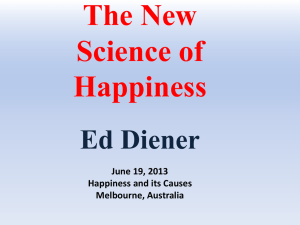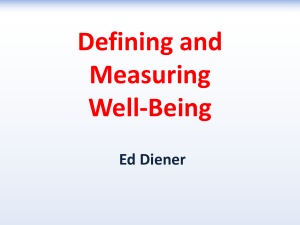i. psichologija
advertisement

5 Mokslo darbai I. PSICHOLOGIJA SOCIAL DEMOGRAPHIC AND PERSONALITY FACTORS RELATED TO WOMAN’S SUBJECTIVE WELL-BEING Prof. dr. Rita Žukauskienė Mykolas Romeris University, Social Faculty, Department of Psychology Valakupiu str. 5, LT–10101 Vilnius Telephon 274 06 09 E-mail laav@is.lt Dr. Julita Navaitienė Vilnius Pedagogical University, Faculty of Pedagogics and Psychology, Department of Psychology Studentu str. 39, LT–08106 Vilnius Telephons 275 10 87, 244 13 92 E-mail gedimin.n@post.5ci.lt Doctoral Candidate Jūratė Kanapinskaitė Vilnius Pedagogical University, Faculty of Pedagogics and Psychology, Department of Psychology Studentu str. 39, LT–08106 Vilnius Telephons 275 10 87 E-mail viva@b4net.lt Received 21 March, 2005. Submitted 31 March 2005. Abstract The relationships between woman’s subjective well-being (SWB), personality traits and sociodemographic factors were explored in the resent study. A sample of Lithuanian women (N=308), age range from 40 to 46, (M=42,4) participated in this study. The results indicate that comparing women in educational level and personal income, large differences were found between categories in these variables. An examination of the joint contribution to explain life satisfaction by the different social demographic variables indicated that the strongest predictors for women's SWB were education and income. The results indicated that married/cohabiting women are indeed more satisfied with their lives than non-married persons. Marital status was even stronger predictor of SWB for participants when considered jointly with other factors. One unexpected finding is that high education and high income became almost non-significant predictors of life satisfaction in our sample when personality variables were added as predictors. Subjective health and especially satisfaction with leisure emerged as important determinants of SWB. However, when personality variables were entered, subjective health became weak predictor of SWB. Overall, our findings indicate that there are substantial SWB mean level differences in relation to social demographic variables. Keywords: subjective well – being; women; social demographic factors. Subjective well-being (SWB) is people’s cognitive and emotional evaluation of their lives, which in our everyday vocabulary is called happiness (Diener, Oishi, Lucas, 2003). Scientific way of looking at happiness or SWB is relatively new theme for research in a world. Life satisfaction is an overall positive perception or feeling about the quality of own life (Corsini, 1999) and it can be broken down in satisfaction with specific important domains like close romantic relations or satisfaction with partner and children. Emotional component of SWB mean “a tendency to respond to one's environment with good or bad feelings, emotions, reactions” (Corsini, 1999). 6 SOCIALINIS DARBAS 2005 m. Nr. 4(1) SWB researchers focused on identifying the external conditions that lead to satisfying lives. For example, Wilson (1967) wrote that the happy person is a "young, healthy, well-educated, well-paid, extroverted, optimistic, worry-free, religious, married person with high self-esteem, job morale, modest aspirations, of either sex and of a wide range of intelligence" (p. 294). Yet after decades of research, psychologists came to realize that external, demographic factors, such as income, health, educational background, and marital status account for only a small amount of the variance in well-being measures. For example, Campbell, Converse, and Rodgers (1976) found that all demographic factors together accounted for less than 20 percent of the variance in SWB. Nevertheless, some demographic variables do consistently predict SWB. Diener, Suh, Lucas, & Smith (1999) reported that the demographic factors such as health, income, religion, marital status, age, education, gender, race, and job morale are related to SWB. In adulthood, subjective well-being often has been linked to marital status or having a close romantic relationship. Diener et al., (1999) in their review of the SWB literature pointed out that it has been found that married persons report being happier and more satisfied with their lives than unmarried persons. Such findings are consistent with the widely held view that marriage, by providing emotional and financial support, can directly enhance personal well-being. Having a child is less often related to general SWB. Diener (1984) reviewing the earlier research on SWB concluded that most studies report that the presence of children in the family has a negative effect or no affect on SWB. However, the results are not consistent. To the extent that children confer utility on parents (Becker, 1981), we would expect children to enhance personal well-being. On the other hand, children are costly and are often the source of considerable anxiety and stress, which can be expected to reduce life satisfaction. More recent research is consistent with this observation, with some studies finding that a negative effect dominates (e.g., Frijters, Haisken-DeNew & Shields, 2004, Di Tella, MacCulloch, & Oswald, 2003), while others have reported insignificant relationships (e.g., Mastekaasa 1994, Evans & Kelley, 2002). Income is the variable that most extensively has been studied as a predictor of SWB. Campbell, at al., (1976) concluded that personal income exerts little influence over subjective well-being. Subsequent reviewers have generally arrived at a similar conclusion. Diener, Sandvik, Seidlitz, & Diener (1993) have found small positive correlations within countries between income and SWB, showing that rich people on average are slightly happier than poor people. Education had been found to be significantly related to SWB (e.g., Campbell, et al., 1976, Diener, et al., 1993), although the correlations are low. Diener, et al. (1999) suggested that the relation might be significant due to the co variation of education with income and occupational status. Education correlates with well-being more for individuals with lower incomes and in poor countries (Campbell, et al., 1997; Diener, et al., 1993). It is possible that a higher educational level might lead to a higher personal income and a higher occupational status that in their turn influences the individual’s level of life satisfaction. Life satisfaction is significantly affected by such factors as leisure and physical health (Argyle, 1999). In surveys reviewed by Veenhoven (1984), happiness was correlated with leisure satisfaction and level of leisure activities at .40, but after controlling for various demographic variables including employment and social class, the correlation fell to .20. Causal effects of leisure on happiness are offered by longitudinal studies. For example, Headey, Holmstrom, and Wearing (1985) followed up 600 Australians at two-year intervals and found that leisure satisfaction increased subjective wellbeing. Strong correlation between health and SWB exists for self-reported health measures (George & Landerman, 1984), but not for objective health ratings by physicians (Watten, Vassend, Myhrer, & Syversen, 1997). Poor health is thought to negatively influence SWB because it interferes with goalattainment (Deci, Ryan, 2000). Subjective health has been found to be associated with subjective wellbeing. Both positive and negative affective indicators of subjective well being demonstrate bivariate associations with self-rated health that are similar in magnitude though, as expected, opposite in valence (Benyamini, et al., 2000). Numerous studies also find significant associations between happiness and self-reported health also when a variety of socio-economic circumstances have been controlled for (Argyle, 1999; Easterlin, 1995). Wilson (1967) reported that the connection between health and subjective well-being holds true for self-reported health measures (see also Diener, et al., 1999). Diener and his colleagues suggested that people's perception of their health is influenced by their personality. For example, individuals who are neurotic report more health disturbances than those who are not. Therefore, selfrated health measures reflect not only the individual's physical condition, but also their emotional adjustment. Mokslo darbai 7 Several reviews of the subjective well-being literature have suggested that personality is one of the major determinants of SWB (e.g., McCrae & Costa 1991, Myers, 1992, Myers, & Diener, 1995). DeNeve & Cooper (1998) found that extraversion and agreeableness were consistently positively associated with SWB, whereas neuroticism was consistently negatively associated with it. Optimism has been found to be constantly related to SWB (Chang & Sanna, 2001). Optimists tend to have positive thoughts about their future when they work for their goals, whereas pessimists tend to have negative thoughts about their future and expect more negative outcomes (Scheier,Carver, 1992). Lyubomirsky et al. (2003) reviewed evidence showing that happiness and high chronic levels of positive affect have benefits in terms of marital quality, income, creativity, sociability, and productivity. In the present study the main focus lies on the importance of social demographic factors for women's general SWB in Lithuania. The social demographic variables as explanatory factors of SWB are at focus because of the changing social and economic conditions after the Lithuania had joined the European Union in 2004. However, in this context the importance of some personality traits such as neuroticism, extraversion, and optimism were also studied. As noted earlier, there is considerable evidence to suggest that some social demographic variables, such as education, income, marriage status or having children do consistently predict SWB. However, the personality variables could be important, for instance, for staying in a marriage, or for finding a well adjusted spouse, or for securing a high income job, which could mean that once personality is accounted for, the social demographic factors could lose their importance. However, research on SWB needs to take into account not just the general impact of these variables, but also how these variables affect SWB differentially at the individual level. The first purpose of the present study is to examine the average difference in subjective well being as measured by global life satisfaction, positive affect and negative affect between middle-aged women in Lithuania. The second purpose is to investigate whether social demographic characteristics, such as marital status, income, child status and education has a different effect on women’s SWB. Method Participants 308 women from various organizations and industries in Vilnius took part at the investigation. The sample was randomly selected from lists of employees, within the specified age range of 40 to 46 (M=42,41, SD=2,13). Procedure Research participants responded to questions related to subjective well - being. Data on such variables as leisure and health as related to social demographic status and personality traits such as neuroticism, extraversion and optimism were also collected. The respondents also provided general demographic information (e.g., age, education, marital status, having/no having children, and income). The research materials were presented to participants in written form, and were completed at on their own. On scheduled time, researchers came back to collect the questionnaires. Measures The research was based on self-reported questionnaires. Subjective Well-Being: Global life satisfaction was measured by three items scale dealing with the women's overall life satisfaction (e.g., How satisfied are you with your life?). The sum of all scores was referred to be a measure of global life satisfaction. The lower the score, the higher level of global life satisfaction was reported. The internal consistency reliability (Cronbach's alpha) was 0,78. Positive Affect and Negative Affect was measured by the Lithuanian translation of the Positive Affect and Negative Affect Schedule (PANAS, created by Watson, Clark, and Tellegen, 1988). Women were asked to describe their usual tendencies to feel. The questionnaire consists of 20 items, each of them was rated in a 4-point scale. The questionnaire is based on the mean score of all answers for each of the subscales. The higher is the score, the higher affect is. The internal consistency reliability (Cronbach's alpha) for our sample was 0,88 and 0,89 for Positive Affect and Negative Affect, respectively. Demographic Factors: Marital status was assigned on the basis of the item "Relation to you of the person who you live with". The women were categorized as being 1=single and 2=married or cohabiting. 8 SOCIALINIS DARBAS 2005 m. Nr. 4(1) The women were categorized both in two and four groups according to their child status. First, the women were assigned to one of four groups: (1) women who had at least one child 0-7 years old that lived with them; (2) women with at least one child older than 7 years that lived with them and no child 0-7; (3) women with at least one child but where none lived with them; and (4) women who had no children at all. Then the women in both samples were categorized as 1=women who had no children at all and 2=women who had at least one child. The women were categorized both in two and four groups on their educational level. First, the women were categorized as 1=women who had less than university/college competence, and 2=women who graduated from university/college. Then the women were assigned to one of the four educational levels in the following way: (1) women who only had compulsory school competence; (2) women who had secondary school competence or two-year vocational upper secondary school competence; (3) women who had 3-4-year high school competence or studied but had not graduated from university/college, (4) women who had graduated from university/college. Personal income was assigned on the basis of the item "How much do you usually earn per month before tax deduction?" The women were categorized both in two and four groups on their personal income. The variable was dichotomized categorizing the women as 1=women with low (below median) personal income and 2=women with high (above median) personal income. The women were also categorized into four groups, e.g., 1=women with low personal income, 2=women with below average personal income, 3=women with above average personal income, and 4=women with high personal income. Additional variables related to social demographic status were leisure and health. A single question: “How satisfied are you with your leisure” assessed Satisfaction with Leisure. Women rated themselves in a scale from 1 to 8 (from "I am totally not satisfied" to "I am totally satisfied"). The variable was dichotomized assigning women who rated their satisfaction with leisure from 1 to 5 to group 1 and women who rated their satisfaction with leisure from 6 to 8 to group 2. Satisfaction with Important Domains: Satisfaction with Health was assessed by asking to answer the question "How satisfied are you with your health?" and to evaluate their health in an 8point scale ranging from "I am totally not satisfied" to "I am totally satisfied". Personality Variables: Neuroticism and Extraversion were assessed by NEO-PI –R (Costa & McCrae, 1992). The NEO–PI–R (Costa & McCrae, 1992) self-report questionnaire consists of 240 items, which are rated on a 5-point scale ranging from 0 (strongly disagree) to 4 (strongly agree). The 240-item NEO-PI-R assesses the FFM domains of neuroticism, extraversion, openness to experience, agreeableness, and conscientiousness. The internal consistency reliability (Cronbach's alpha) was 0,87 and 0,88 for Neuroticism and Extraversion scales, respectively. Optimism was assessed by the Optimism scale consisted of five items (e.g., "I am a person that has a very positive view toward life"). Participants rated on a 4-point scale ranging from 1 (does not apply at all) to 4 (applies completely). The Optimism scale is based on the mean score of the sum of five item scores. A higher total score indicates a higher level of optimism. Persons with missing data in more than one item were excluded from the scale. The internal consistency reliability (Cronbach's alpha) was 0,80. Results The three major components of general SWB are life satisfaction, positive affect, and negative affect. The means and standard deviations in SWB for our sample (N=308) are shown in Table 1. T a b l e 1 . Means and Standard Deviations in Subjective Well-Being SWB component Global Life Satisfaction Positive Affect Negative Affect M 5,60 3,37 2.05 SD 1,21 0.63 0.65 Table 2 shows that the largest difference between categories is found in Global Positive Affect when women who are married/cohabiting are compared to women who are single, F=3,64, P<0,05. The differences between categories are found for Educational level and Personal income for all three SWB variables. Comparing the extreme groups in these variables, we find effect sizes varying between 0,71 and 0,76. Largest differences between four categories is found for Higher educational 9 Mokslo darbai and for income, all these differences were highly significant for Global Life Satisfaction, Positive Affect, and negative Affect. T a b l e 2 . Social Characteristics and Subjective Well-Being Variable Marital status: Married/cohabiting Single Women who had: At least one child No children Child status: No children At least one child 0-7 y At least one child older than 7y. At least one child but no one at home Educational level: Low Below average Above average High Personal income: Low Below average Above average High Global life satisfaction F=2,61ns 5.70 (N=215) 5,46 (N=90) F=2.47 ns 5,59 (N=276) 5,96 (N=30) F=1,54 ns 5,96 (N=30) 5,86 (N=36) 5,54 (N=166) 5,59 (N=74) F=7,64*** 4,96 (N=18) 4,98 (N=15) 5,27 (N=59) 5,83 (N=214) F=11,37*** 5,15 (N=85) 5,48 (N=67) 5,76 (N=73) 6,15 (N=81) Positive affect Negative affect F=3,64* 3.33 (N=214) 3,48 (N=90) F=0.01 ns 3,38 (N=274) 3,37 (N=30) F=1,18 ns 3,37 (N=30) 3,43 (N=36) 3,32 (N=166) F=1,44 ns 2.08 (N=214) 1,98 (N=90) F=0.33 ns 2,05 (N=274) 1,98 (N=30) F=1,10 ns 1,98 (N=30) 1,98 (N=36) 2,11 (N=166) 3,48 (N=74) F=8,56*** 2,97 (N=18) 3,09 (N=14) 3,15 (N=59) 3,49 (N=214) F=6,19*** 3,18 (N=85) 3,37 (N=67) 3,38 (N=71) 3,60 (N=81) 1,97 (N=74) F=2,76* 2,38 (N=18) 2,2(N=14) 2,09 (N=59) 1,99 (N=214) F=3,94** 2,22 (N=83) 2,05 (N=67) 2,05 (N=62) 1,88 (N=61) Note: * p<0,05, ** p<0,01, *** p<0,001 Consistent with most recent research, the results reported here suggest that Global Life Satisfaction and Positive Affect of Lithuanian women is not affected by the presence or absence of children, as the mean differences among the groups of women with regard to age or presence of the child in the family are non-significant. To examine the joint contribution to explaining Global Life Satisfaction by the different social demographic variables, we performed a multiple regression analysis with Marital status, Having children, Educational status, Income as the independent variables (dichotomized variables) and Global Life Satisfaction as the dependent variable. Then in a second step we entered Marital status, Having children, Educational status, Income (objective dichotomized variables) and Good Self-rated Health and Satisfaction with Leisure (subjective dichotomized variables) as the independent variables, and Global Life Satisfaction as the dependent variable to see if the prediction of and Global Life Satisfaction was improved. The results are given in Table 3. 10 SOCIALINIS DARBAS 2005 m. Nr. 4(1) T a b l e 3. Summary of a Two-Steps Multiple Regression Analysis with Social Demographic Variables and Satisfaction with Leisure and Health Predicting Global Life Satisfaction Step 1 (Only objective variables entered) Married/cohabiting Having children High education High income Step 2 (Objective and subjective variables entered) Married/cohabiting Having children High education High income Good self- rated health High satisfaction with leisure B t 0,17 0,28 0,40 0,48 2,22* 1,21n.s. 2,46** 3,23*** 0,20 0,30 0,34 0,39 0,32 0,89 2,97** 1,48n.s. 2,34* 2,96** 2,47** 7,14*** R2 0,11*** 0,31** * p<0,05, ** p<0,01, *** p<0,001 It is seen in Table 3, that for middle-aged women Married/cohabiting was a significant predictor but the strongest predictors of subjective well-being were High income and High education. The squared multiple correlation is 0,11. When subjective variables (Satisfaction with Leisure and Health) were added to the prediction equation, the results indicated that High Satisfaction with Leisure and Satisfaction with Health were significant predictors of Global Life Satisfaction. Marital status became more important, when subjective variables were entered with socio demographic variables. The squared multiple correlation was now 0,31, still indicating a modest predictive power. In Table 4 the results of three-steps regression analyses are presented for Global Life Satisfaction (dependent variable). We entered as predictors personality variables (Extraversion, Neuroticism and Optimism) first, Marital status, Child status, Income level, Education Level second, and Satisfaction with Health and Leisure third. Before the analysis, categorical variables were dichotomized. The results showed, that the personality variables increased predictive power of Global Life Satisfaction. T a b l e 4 . Summary of Three-Steps Regression Analyses with Personality Variables, SocioDemographic Variables and Domain Satisfaction Variables Predicting Global Life Satisfaction Step 1 (personality variables entered) Neuroticism Extraversion Optimism Step 2 (socio demographic variables also entered) Neuroticism Extraversion Optimism Married/cohabiting Having children High education High income Step 3 (socio demographic variables, Leisure, and Health also entered) Neuroticism Extraversion Optimism Married/cohabiting Having children High education High income Health Leisure ** p<0,01, *** p<0,001 B t -0,02 0,00 0,56 -3,87*** 0,81 4,03*** -0,02 0,00 0,53 0,23 0,39 0,21 0,28 -3,72*** 0,56 3,82*** 3,31*** 1,82* 1,37 2,01* 2 R 0,21*** 0,26*** 0,40*** -0,01 -0,00 0,47 0,24 0,38 0,22 0,24 0,26 0,77 -2,75** -0,01 3,75*** 3,84*** 1,93* 1,55 1,91* 2,13* 6,38*** Mokslo darbai 11 It is seen in Table 4 that the personality variables are stronger predictors of Global Life Satisfaction than the social demographic variables are but the explained variance is low. Neuroticism and Optimism were the strongest predictors of Global Life Satisfaction accounting for 21% of the variance, respectively. When the social demographic variables were added to the personality variables as predictors of Global Life Satisfaction, the prediction improved significantly. Married/cohabiting increased its importance for Global Life Satisfaction as well. In the third step of the regression analysis is seen that Leisure is a strong predictor of Global Life Satisfaction. Discussion The results of the present study indicate that the level of individual self-reported happiness in Lithuania is much below than that of Western Europe (Inglehart, & Klingemann, 2000). In Lithuania, only 4 percent of women rated themselves as "very happy" and 44 percent as "satisfied" on a Life satisfaction scale. The relative unhappiness in Lithuania is likely to be related to the negative consequences of the transition process. Economic transition has resulted in rising unemployment, inequality and poverty. As Winkelmann and Winkelmann (1998) have shown, there is a prevailing negative relationship within countries between unemployment, low income, inequality, and happiness. The main differences between categories are found in Global Life Satisfaction when women who are married/cohabiting are compared to women who are single. The differences between categories are instead found for educational and income for all three SWB variables. This finding is in accordance with the findings from Diener & Diener (1996) study where strength of the relations between satisfaction with specific domains (family, friends, finances) and life satisfaction was examined in college students from 31 nations. They found that financial status was more correlated with life satisfaction in poorer nations than wealthier nations. Not surprisingly then, that an examination of the joint contribution to explaining life satisfaction by the different social demographic variables in our study indicated that the strongest predictors of life satisfaction for Lithuanian women were education and income. Partly, it could be explained by a higher salary related to higher education qualifications, or with a higher social status in the society of educated people. However, these findings need further clarification. The results indicated that married/cohabiting women are indeed more satisfied with their lives than non-married persons. Marital status was even stronger predictor of SWB for Lithuanian women when considered jointly with other factors. One unexpected finding is that high education and high income became almost non-significant predictors of life satisfaction when personality variables were added as predictors. It could be explained by the highly competitive Lithuanian society with a high job mobility and in-security, which make personality more important for securing a high income job which in its turn means that once personality is accounted for, income and education lose their importance. Subjective health and especially satisfaction with leisure emerged as important determinants of SWB. However, when personality variables were entered, subjective health became weak predictor of SWB. These findings are in accordance to Diener et al. (1999) suggestion that people's perception of their health is influenced by their personality. Overall, our findings indicate that there are substantial mean level differences in SWB of women, as well as differences in relation to social demographic variables. However, to answer the question if these differences result from national wealth only, the replication on a new Lithuanian sample in, say after 5-10 years, could provide additional data showing if rapid economical growth and change in wealth in Lithuania will be accompanied by changes in SWB. Ahuvia and Friedman (1998) suggested that economic growth is linked to such changes as improvements in democracy and health, which, in turn, are linked to subjective well-being. REFERENCES 1. Ahuvia A., Friedman D. Income, consumption and subjective well being: Toward a composite macromarketing mode // Journal of Macromarketing, 1998. Vol. 18. 2. Argyle M. The Social Psychology of Leisure. – London: Penguin, 1996. 3. Argyle M. Causes and correlates of happiness / D. Kahneman, E. Diener and N. Schwarz. Well-Being. The Foundations of Hedonic Psychology. – New York: Russell Sage Foundation, 1999. 12 SOCIALINIS DARBAS 2005 m. Nr. 4(1) 4. Becker G. A Treatise on the Family. – Cambridge, Massachusetts: Harvard University Press, 1981. 5. Benyamini Y., Idler E., Leventhal H., Leventhal E. Positive affect and function as influences on self6. 7. 8. 9. 10. 11. 12. 13. 14. 15. 16. 17. 18. 19. 20. 21. 22. 23. 24. 25. 26. 27. 28. 29. 30. 31. 32. 33. 34. 35. assessments of health: Expanding our view beyond illness and disability // Journal of Gerontology: Psychological Sciences. 2000. Vol. 55. Campbell A., Converse P. Rodgers W. The quality of American life. – New York: Russell Sage Foundation, 1976. Chang E., Sanna L. Optimism, pessimism, and positive and negative affectivity in middle-aged adults: A test of a cognitive-affective model of psychological adjustment // Psychology and Aging. 2001. Vol. 16. Corsini R. Dictionary of psychology. 1999. Costa P., McCrae R. Normal personality assessment in clinical practice: The NEO Personality Inventory // Psychological Assessment. 1992. Vol. 4. Deci E., Ryan R. The “what” and “why” of goal pursuits: Human needs and the self-determination of behavior. Psychological Inquiry. 2000. Vol. 11. DeNeve K., Cooper H. The happy personality: a meta-analysis of 137 personality traits and subjective wellbeing // Psychological Bulletin. 1998. Vol. 124. Diener E. Subjective well-being // Psychological Bulletin. 1984. Vol. 95. Diener E., Diener C. Most people are happy // Psychological Science. 1996. Vol. 7. Diener E., Oishi S., Lucas R. E. Personality, culture, and subjective well-being: emotional and cognitive evaluation of life // Annual review of psychology. 2003. Vol. 54. Diener E., Sandvik E., Seidlitz L., Diener M. The relationship between income and subjective well-being: Relative or absolute? // Social Indicators Research. 1993. Vol. 28. Diener E., Suh E., Lucas R., Smith H. Subjective well-being: Three decades of progress // Psychological Bulletin. 1999. Vol. 125. Di Tella, R., MacCulloch, R. Oswald, A. The Macroeconomics of Happiness // The review of Economics and Statistics. 2003. Vol. 85(4). Easterlin R. Will raising the income of all increase the happiness of all? // Journal of Economic Behavior and Organization. 1995. Vol. 27. Evans M., Kelley J. Australian Economy and Society 2001: Education, Work, and Welfare. – Sydney: Federation Press, 2002. Frijters P., Haisken-DeNew M., Shields M. Changes in the pattern and determinants of life satisfaction in East and West Germany following reunification // Journal of Human Resources. 2004. Vol. 39. George L., Landerman L. Health and Subjective Well-Being: A Replicated Secondary Data Analysis // International Journal of Aging and Human Development. 1984. Vol. 19. Headey B., Holmstrom E., Wearing J. Models of well-being and ill-being // Social Indicators Research. 1985. Vol. 17. Inglehart R., Klingemann H. Genes, culture, and happiness / E. Diener, E. Suh (Eds.). Subjective well-being across cultures. – Cambridge, MA: MIT Press, 2000. Lyubomirsky S., King L., Diener E. Is happiness a good thing? A theory of the benefits of positive affect. Unpublished manuscript. Department of Psychology, University of California, Riverside, 2003. Mastekaasa A. Marital Status, Distress, and Well-being: An International Comparison // Journal of Comparative Family Studies. 1994. Vol. 25. McCrae R., Costa P. Adding Liebe and Arbeit: The full five-factor model and well-being // Personality and Social Psychology Bulletin. 1991. Vol. 17. Myers D. The Pursuit of Happiness: Who is happy – and why. – William Morrow and Company, Inc., 1992. Myers D., Diener E. Who is happy? // Psychological Science. 1995. Vol. 6. Scheier M., Carver C. Effects of optimism on psychological and physical well-being: Theoretical overview and empirical update // Cognitive Therapy and Research. 1999. Vol. 26. Tran T., Wright R., Chatters L. Health, stress, psychological resources, and subjective well-being among older blacks // Psychology and Aging. 1991. Vol. 6. Watson D., Clark L., Tellegen A. Development and validation of brief measures of positive and negative affect: The PANAS scales // Journal of Personality and Social Psychology. 1988. Vol. 54. Watten R., Vassend D., Myhrer T., Syversen J. Personality factors and somatic symptoms // European Journal of Personality. 1997. Vol. 11. Veenhoven R. Conditions of happiness. – Dordrecht, The Netherlands: D. Reidel Publishing, 1984. Wilson W. Correlates of avowed happiness // Psychological Bulletin. 1967. Vol. 67. Winkelmann L., Winkelmann R. Why are the unemployed so unhappy? Evidence from panel data // Economica. 1998. Vol. 65. Mokslo darbai 13 MOTERŲ SUBJEKTYVIOS GEROVĖS IŠGYVENIMAS IR SU JA SUSIJĘ SOCIALINIAI, DEMOGRAFINIAI BEI ASMENYBINIAI VEIKSNIAI Prof. dr. Rita Žukauskienė Mykolo Romerio universitetas Dr. Julita Navaitienė Vilniaus pedagoginis universitetas Doktorantė Jūratė Kanapinskaitė Vilniaus pedagoginis universitetas Santrauka Tyrimas skirtas moterų subjektyvios gerovės ir socialinių demografinių veiksnių ryšiui nustatyti. Tyrime dalyvavo 308 Lietuvos moterys, kurių amžiaus ribos svyravo nuo 40 iki 46 metų. Vidutinis tiriamųjų amžius – 42,4 metų. Nustatyta, kad moterų subjektyvi gerovė susijusi su socialiniais demografiniais veiksniais. Tyrimo rezultatai taip pat parodė, kad didžiausi buvo moterų rasti išsilavinimo lygio ir asmeninių pajamų skirtumai. Stipriausi moterų subjektyvios gerovės prognostiniai kintamieji buvo išsilavinimas ir pajamos. Ištekėjusios arba turinčios partnerį moterys buvo labiau patenkintos gyvenimu negu netekėjusios moterys. Vedybinis statusas buvo stipresnis subjektyvios gerovės prognostinis rodiklis, kai buvo vertinamas kartu su kitais veiksniais. Netikėtas atradimas buvo tai, kad aukštas išsilavinimo lygis ir didelės pajamos nebuvo subjektyvios gerovės prognostiniai rodikliai, kai buvo vertinami kartu su asmenybiniais veiksniais. Subjektyviai įvertinta sveikata ir pasitenkinimas laisvalaikiu pasirodė esą svarbūs subjektyvios moterų gerovės veiksniai, tačiau jų reikšmingumas sumažėjo juos vertinant kartu su asmenybiniais veiksniais. Pagrindinės sąvokos: subjektyvus gerovės išgyvenimas, moterys, socialiniai demografiniai veiksniai.





